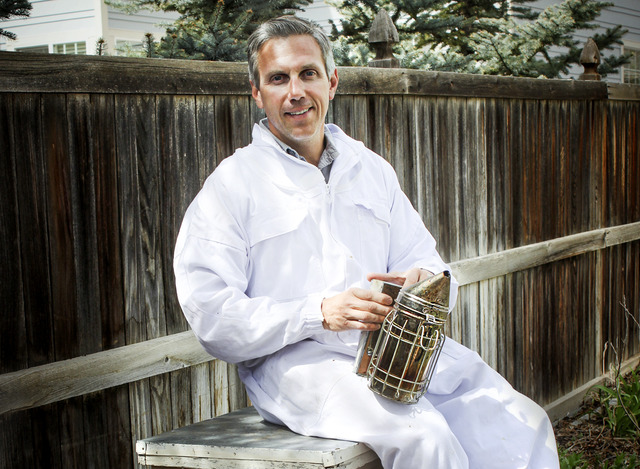The Local newsletter is your free, daily guide to life in Colorado. For locals, by locals.
On an unusually warm day in February, Nick French rifles through the trunk of his Honda CRV. A tool kit holds stained work gloves, a torch lighter, scraps of raw beeswax, and a crumpled beekeeper’s suit. We’re in a field in Parker, home to 10 of French’s hives. Each sea-foam-colored box is stamped with “Frangiosa Farms,” and underneath an emblazoned honeybee it reads, “No Bees, No Food.”
French, the 43-year-old owner of Frangiosa Farms, started beekeeping about eight years ago when his neighbor gifted him a hive. It began as a hobby, but one hive morphed into 20. Today, his buzzing empire continues to grow, thanks to a community-supported agriculture program he began a few years back. French based the structure of his initiative—which he dubbed Adopt-A-Honey-Bee—on a CSA-like program in England that allows patrons to buy a so-called hive share. In return, they receive jars of honey.
With French’s help, I suit up in protective gear before we check on the colony. Each box shelters 25,000 to 60,000 bees, depending on the time of year, and I can hear their ominous hum from a few feet away.
French uses a torch lighter to ignite a smoker and, depressing it like an accordion, puffs gray clouds into the hive’s many crevasses. He says the smoke calms the bees, but as he pries open the box, they look angry to me. A bee flies into my face screen, causing me to flinch. “Bees are attracted to motion,” French warns.
As he works, the beekeeper talks about the hardships bees have faced in recent years: pollution and pesticides, the loss of places to forage, and GMO crops, plus the mites and diseases that normally affect bees. All of these factors have been leading to colony collapses across the country.
To ensure good hive health, French keeps his bees far from commercial farming to limit exposure to chemicals and pollutants, uses organic methods to battle mites, and monitors the bees’ food supply when nectar is scarce. As long as his bees are thriving, French offers shares for $45 to $530 a year, which nabs participants between one and twelve 12-ounce jars of Colorado honey per month.
Today is the first time he’s seen the bees since October. He looks for eggs to make sure the queen is healthy and reproducing. He observes the amount of honey and gives it an approving nod. Then he says: “This is the best part of beekeeping and the most dangerous part.” He takes off one glove and drags his finger through a patch of raw, viscous honey. The bees don’t seem to notice. “You ready?” he asks. Moving slowly, I remove a glove and unzip my hood. Then I take a swipe. The reward is sweet and pure.
Honey CSA
Shares: $45–$530 per year









